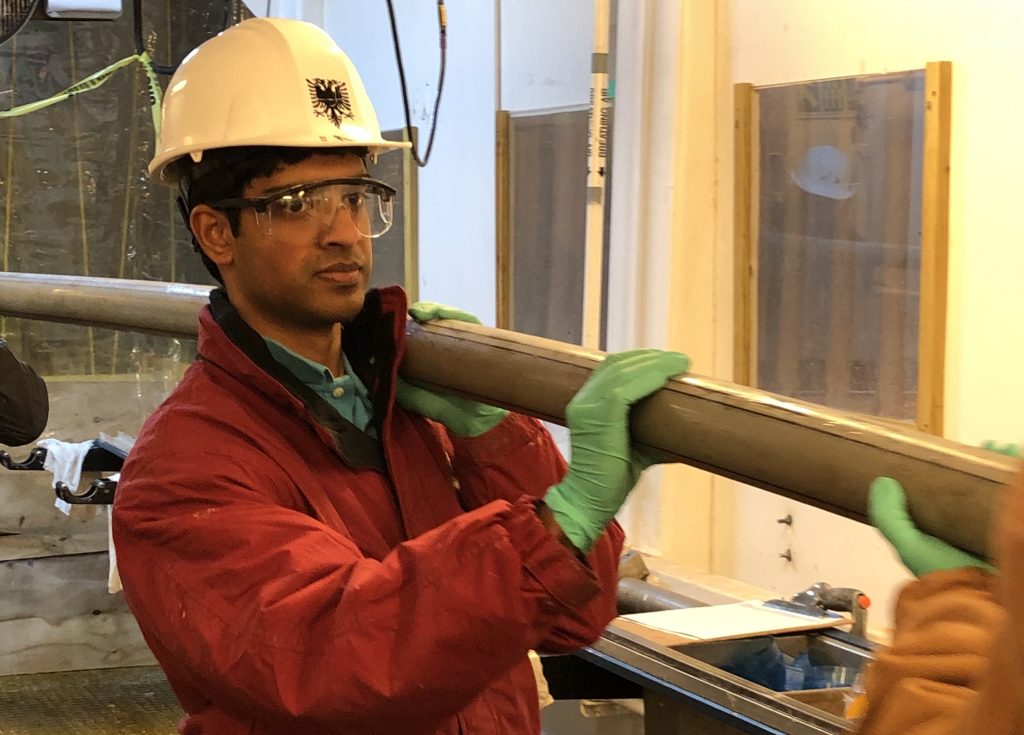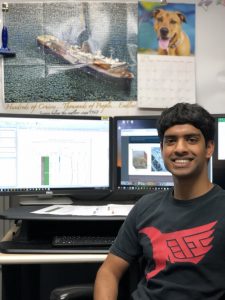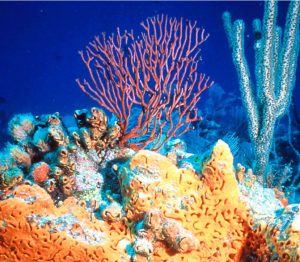
Career Spotlight: Publications Specialist Ekant Desai

-Worked on the JR before: Yes
Ekant Desai Interview
Please describe your job duties while on the JR. What will you be doing on a daily basis?
-
-
-
-
-
-
-
-
- I produce the visual core descriptions, compile the expedition report materials for the publication, do administrative things, and I make sure everyone who has birthday while onboard gets a cards!
-
-
-
-
-
-
-
Describe one instrument or tool that is essential for you to do your job? Or a piece of equipment on the JR that is useful and why – what does it do?
-
-
-
-
-
-
-
-
- While on the ship, I produce the Visual Core Descriptions. After the 9.5 meter core comes up, it is cut, scanned by numerous instruments, and described by the science party. I download that information, take the data I need, and plot it on a single 8.5×11 inch piece of paper. This is done for every core drilled during the expedition and provides everyone with a concise visual summary of each core. I use a piece of borehole plotting software called Strater to create these visuals.
-
-
-
-
-
-
-
Why is your work (or research) important? What question are you trying to answer or how does your work/research help assist/advance scientific knowledge?
- My work is all about producing a publication documenting the research conducted onboard the JR. On ship, I collect all the data I need and, on shore, I work with the rest of the publications department to produce the final publication. I’m basically here to support the scientists and provide any sort of publication related help they might need. The less they have to worry about the technical aspects of how their work will make its way through to the final publication, the more they can focus on what they are here for, the actual science.

Why the ocean? What made you choose a career at sea or career that involves the ocean?
- Before this job, I had never sailed on any type of boat or anything. It was an experience completely un-known to me. So, when I came across the job posting, it seemed like a very interesting and unique operation. The experience of working closely on a ship for two months seemed like a great opportunity, not only to meet different kinds of people, but also to see how we, as humans, work together and pool different skillsets to meet a unified goal. The ship crew, science party, staff, and drilling engineers all have completely different jobs but ultimately are working towards the same thing. I have learned a lot by being a part of this.
What are you most excited about for this expedition and/or being on the JR?
- I am most excited about watching the operation. From when core comes up, to when it goes to the various labs, to when the reports all come back to me. It’s a well-oiled machine.
What are three things you think are needed for a successful expedition at sea? And Why!
- For everyone to be positive and try to relate to one another. Interacting with only the same people for 60 days can be trying if you let it. Just don’t let it!
- For everyone to try to keep their perspectives fresh. Burnout can be real toward the end if you look at things in the same way over and over again.
- Lastly, focus on the work! In case of any sticky situations, focusing on what we know we have to do can be very therapeutic and steadying.
What do you personally hope to gain or experience while on EXP383?
- Just to observe and experience as much as I can. It’s such a multi-national spread that you get so many different perspectives on the same things. Sometimes it really makes you re-consider your own views.
What is your favorite sea creature and why?
- Sponges – It’s a very spiritual existence being a sponge. They don’t have brains, stomachs, or appendixes. They simply let water flow through them to gain nutrients and carry away waste. Life literally flows through them for their whole lives. Also in terms of evolution, they were one of the first creatures to branch off so they’re siblings to almost everything!

What do you do back home when not on the JR?
- My regular job back home is in the office working on the graphics of the publication. I do that most of the year, and get to sail maybe once every year. The JR produces expedition reports every 2 months so it’s a sizable publications department back home.
Do you get sea sick? If yes or sometimes, please also select the other tab and describe how you cope with it.
- Yes: The doctor has Bonine and it does the trick for me. 1 pill for breakfast every day.
The need for space comes in many forms. Which type of space, in general, is the most important to you?
- ___Personal Space
- ___Creative Space
- _X_Outdoor Space
- ___Emotional Space
- ___Physical Space
- ___Spiritual or Meditative
- ___Outer Space
- ___Community Space
- ___Quite Space
- ___Productive/Work Space
- ___Digital/Virtual Space
- ___Public Space
- ___Inner Space
- ___Other:
Why that type of space? What makes it important to you and will it be available while on the JR?
There’s something instinctively calming about Earths natural beauty and I appreciate it very much. While we don’t get a lot of what I normally seek out, looking out over the ocean can be great to clear the mind as well.
Well done Ekant!! Enjoyed your thoughtful commentary.